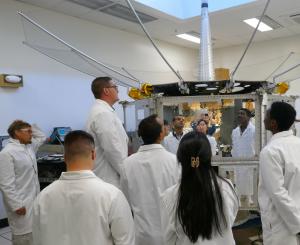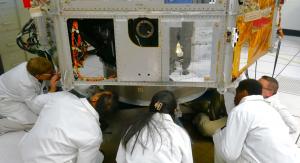The Last Telemetry of FLTSATCOM

Naval Postgraduate School students participate in the last class ever to operate FLTSATCOM. For more than 30 years, it has given students unparalleled experience commanding a working satellite.
For more than 30 years, the groundbreaking Navy communications satellite at Naval Postgraduate School advanced knowledge of satellite design and operations.
MONTEREY, CA, UNITED STATES, September 12, 2025 /EINPresswire.com/ -- A vanguard of NPS’ illustrious space program just received and sent its final transmissions. It’s now gone dark, fate uncertain. The $110-million, ground test (qualification) model of the U.S. Navy’s Fleet Satellite Communications System (FLTSATCOM) was established at NPS in 1992 and began operating to help educate and train hundreds of NPS students to become space systems engineers and operators for the nation’s military and civilian space programs.
For more than 30 years, FLTSATCOM remained a fixture of NPS’ Spacecraft Research and Design Center. However, the center’s laboratories are being forced to relocate due to a complete renovation of the building that houses them. This will leave FLTSATCOM lost without a space.
“Getting FLTSATCOM into NPS was a tremendous milestone,” said Distinguished Professor Brij Agrawal of the NPS Department of Mechanical and Aerospace Engineering, who spearheaded the acquisition of the satellite. “Having it operating here gave students an unparalleled opportunity to solve real-world problems by running experiments on an actual communications satellite that was state-of-the-art for its time.”
Former NASA administrator Dan Goldin was there for its unveiling at NPS. Back then, he was vice president of TRW Inc., which manufactured the FLTSATCOMs. The satellite that NPS received was what the former aerospace company used to develop, test, and qualify all the others that made it into orbit.
So instead of being mothballed or harvested for parts, this FLTSATCOM model’s life was extended for decades to advance the expertise of the students who would soon be building real spacecraft—and other important aerospace-related systems—and operating them, from the seafloor all the way up into space.
In their heyday, FLTSATCOMs provided the backbone of worldwide, high-priority ultrahigh frequency (UHF) communications designed to support the U.S. Navy, U.S. Air Force, Department of Defense, and the U.S. Presidential Command Network.
From 1978 to 1989, six FLTSATCOMs were successfully launched. According to a NASA launch mission summary of one launched from Kennedy Space Center Launch Complex 39A, “The FLTSATCOM is the largest and heaviest spacecraft ever to be launched into geosynchronous orbit by an Atlas/Centaur vehicle.”
Nowadays, only one remains operational. They have an antenna dish diameter measuring 4.9 meters, a solar array spanning 13.2 meters, and a launch mass weighing between 1,884–2,310 kilograms.
Fred Kuipers, a Qualtec contractor for the U.S. Space Force, guest lectured at the laboratory on Aug. 28, 2025. His team manages the FLTSATCOM currently in orbit and has helped maintain the functionality of NPS’ satellite in the laboratory.
Kuipers gave hands-on experience with FLTSATCOM to five students, all of whom are U.S. Navy officers studying space systems engineering. First, they carefully examined its features and construction, even climbing on a ladder for close inspections of the lofty antennas and underneath it for a view inside its apogee kick motor. However, the solar array wasn’t ever attached, so external power has run the satellite.
“We’ll have headquarters down at Point Mugu and be prime in command, and the backup site will be out at Schriever in Colorado reviewing telemetry,” said Kuipers, preparing the simulation for the students to operate FLTSATCOM. “We perform periodic solar array updates, like the one the students will attempt. If the array becomes too off-pointed, the satellite will lose power.”
The students then broke into three groups. The first group took the roles of an engineer and operator controlling the satellite from Point Mugu. The second played the backup ground control station, and the third was a student who physically replicated the Sun by shining a light at a sensor on the satellite.
Using actual checklists and following exact procedures on ground computer systems, the students commanded the satellite as if it were in orbit. The Point Mugu group tasked the satellite to tilt its solar array to face the direction of the Sun. Though the array wasn’t there, its actuation motors still remained.
Quickly the motors hummed to life in the laboratory and began rotating. The backup group verified that motors did rotate, which would have caused the satellite to change the position of its solar array, had it been attached. The students shifted their roles and completed tasking other satellite operations.
After the students finished, the last class ever in the laboratory had reached its end, and FLTSATCOM’s telemetry finally fell silent once and for all.
Before becoming a maritime space officer in the information warfare community at NPS and taking Agrawal’s space systems laboratory class, U.S. Navy Lt. Cmdr. Kamil Bahadar flew MH-60S Seahawk helicopters and then was assigned to the Naval Research Laboratory’s Space Engineering Department. After NPS, he’ll be transferred to United States Space Command.
“FLTSATCOM is a real-life qualification model, which is so cool to see,” said Bahadar. “It's just a very rare opportunity for students to be able to command a real-life system.”
Learning about FLTSATCOM, its history, and its uncertain future inspired Bahadar to search for a worthy new landing spot for the wayward satellite. “I believe FLTSATCOM is such an important asset with so much naval space heritage that it should be preserved,” he added.
Although long overdue campus renovations will displace the satellite, Bahadar hopes to find a new partner to continue FLTSATCOM’s renewed life in education, or at least a suitable place to recognize and honor its remarkable history.
The building renovations will cause another pioneering member of the Spacecraft Research and Design Center to become homeless at NPS, but the National Reconnaissance Office (NRO) might take this one back.
In 2010, NRO gave NPS a state-of-the-art Segmented Mirror Space Telescope (SMT). Its mirror is three meters wide and consists of six hexagonal segmented panels with surfaces precisely controlled by adaptive optics. This advanced technology allows the SMT to have much improved optical resolution and focus on distant objects. The operation of NASA’s James Webb Space Telescope (JWST), which launched in 2021, was developed from this technology.
Like FLTSATCOM, the SMT never made it to space. However, both spacecraft were built to be steppingstones. SMT was the first spacecraft demonstrator ever to have fully functioning segmented mirrors.
“Both of these systems, FLTSATCOM and the SMT, have been extremely valuable over the years and have contributed to student learning and research in many significant ways,” said former NASA astronaut and acting NPS Provost Jim Newman, recognizing the importance of NPS’ legacy spacecraft.
Newman is a veteran of four Space Shuttle missions, including a mission where he spacewalked to repair the Hubble Space Telescope, which is the predecessor of JWST.
“We will miss having them as resources on campus but hope that they may have value at their new homes to either help in future students’ education or to serve as a historical reminder of these important technologies and how the capabilities we have in space today have been developed over many years and with great success,” Newman added.
-------------------
Established in 1909, Naval Postgraduate School (NPS) provides defense-focused graduate education, including classified studies and interdisciplinary research, to advance the operational effectiveness, technological leadership and warfighting advantage of the Naval service. Located in Monterey, California, NPS offers master’s and doctoral programs for U.S. military and civilians, federal agencies, allied militaries and partner nations.
LCDR Kristina Wiedemann, USN
Naval Postgraduate School, Public Affairs
+1 831-656-3567
email us here
Visit us on social media:
LinkedIn
Instagram
Facebook
YouTube
X
Legal Disclaimer:
EIN Presswire provides this news content "as is" without warranty of any kind. We do not accept any responsibility or liability for the accuracy, content, images, videos, licenses, completeness, legality, or reliability of the information contained in this article. If you have any complaints or copyright issues related to this article, kindly contact the author above.


